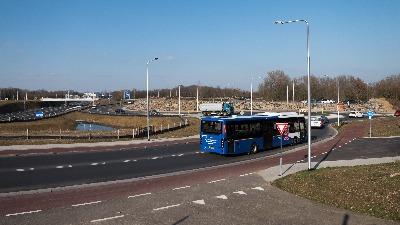Sustainable mobility
The municipality of Kerkrade considers sustainability to be very important. That is why many projects are carried out under the name: "Sustainable Kerkrade. The municipality has been working on this for several years. Take examples such as the solar panel project Parkstad, sustainability car d'r Greeny, sustainability lessons at schools and film evenings for residents in Columbus Earth Center. In total, the municipality is working with a variety of partners on some 30 projects. Together with the other Parkstad Limburg municipalities, Kerkrade has set itself the goal of becoming energy-neutral by 2040.

Within the theme of sustainability, the municipality would like to tell you about so-called sustainable mobility in three articles. That sounds nice, but what does it really mean? In article 1 we will answer that question. We also talk about climate change. Article 2 focuses on fossil fuels and increased use of bicycles. In the third and final article we talk about economical driving and applying for a charging station.
Article 1
What is sustainable mobility?
Mobility is how we get from A to B. We can do that by car, but also by train, truck, bus, etc. If we do it sustainably, then of course cycling or walking is best! But public transportation is also already better for the environment. The car, truck, plane etc. gives more emissions of harmful gases. Two examples of sustainable mobility in Kerkrade are realizing charging points for electric cars and advising companies.
Climate Change
The effects of climate change are increasingly visible and measurable. The trend of rising temperatures is expected to continue for the foreseeable future. Globally, expected impacts include rising sea levels, increased forest fires and threats to public health from freshwater shortages and changes in food production.
Extreme weather conditions are increasing in the Netherlands. Drier summers, for example, are causing water levels in the Meuse to drop, creating problems for inland shipping, nature and for the intake of drinking water from the Meuse. As a result, the Limburg Water Board has to take extra measures, causing Limburg households to pay more water taxes.
Mobility in the Netherlands is on average responsible for about 25% of total CO2 emissions in a year. Especially car and truck contribute to this, but also air traffic. If we want to reduce total emissions, in addition to energy savings in homes and industry, we must also look at the way we travel.
Article 2
Stop burning fossil fuels
The way we largely move around today is depleting global supplies of fossil fuels. Burning these fuels contributes to climate change. It also causes air pollution, resulting in environmental and health damage.
How could it be otherwise?
The way we get around affects the environment. It matters whether we travel by car, motorcycle, public transportation or bicycle. For each situation and moment, the environmental impact of the means of transportation varies. It depends, among other things, on when you travel, the type of car or the type of public transport. The number of people traveling also has an influence. Electrically powered transport (electric car) is a cleaner choice than means of transport with a combustion engine (regular engine). Walking, cycling and traveling by (electrically powered) train are therefore the least environmentally damaging.
If you take the bike more often, it does not cost fuel, does not release pollutants into the environment and gives a feeling of satisfaction because at that moment you are not contributing to climate issues and depletion of fossil fuels. Increased exercise on a bicycle also improves fitness and keeps muscles trained. Therefore, cycling is the best way to make a positive contribution to the environment and also promote health.
Article 3
Driving a car bad for the environment
Driving a car causesCO2 emissions into the air by burning gasoline and diesel, which contributes to climate change. In addition, the car causes damage to our health and nature by emitting air pollutants. The electric car is an exception to this.
Saving money and the environment with the right foot
With some minor adjustments in driving style, you can drive yourself economically. This saves fuel (up to 10%) and thus the environment! This is also called "The New Driving" or "Economical Driving".
The tips (TNO, 2009):
- Shifting gears: Depending on the load, shift to a higher gear as quickly as possible. With a gasoline engine, this can be done as early as 2000-2500 rpm. With diesel engines even at even lower revs.
- 80 in 5! When driving in top gear, the car is more economical.
- Look ahead: Release the gas in time and let the car roll out in gear if you can.
- Engine off: At short stops, such as a railroad crossing, turn off the engine.
- Accessories: If possible, make use of cruise control and on-board computer.
- Energy Consumers: Consumers such as air conditioning and rear window heaters increase fuel consumption.
- Tire pressure: Check tires monthly against the prescribed tire pressure. Insufficient pressure causes more resistance and thus higher fuel consumption.
- Car buying: When buying another car, pay attention to the car's energy label (A through G). Cars with energy label A are the most economical.
Application for placement of charging station
If residents or businesses do not have their own site for electric car charging, they can currently apply to install a nearby charging station. All charging stations are supplied with 100% wind energy from wind farms in the Netherlands. Users can use a pass to charge their electric car at a favorable rate after placement.
A public charging point can be requested at: https://www.nuon.nl/producten/elektrisch-rijden/formulieren/aanvraag-publieke-laadpaal-brabant-en-limburg/